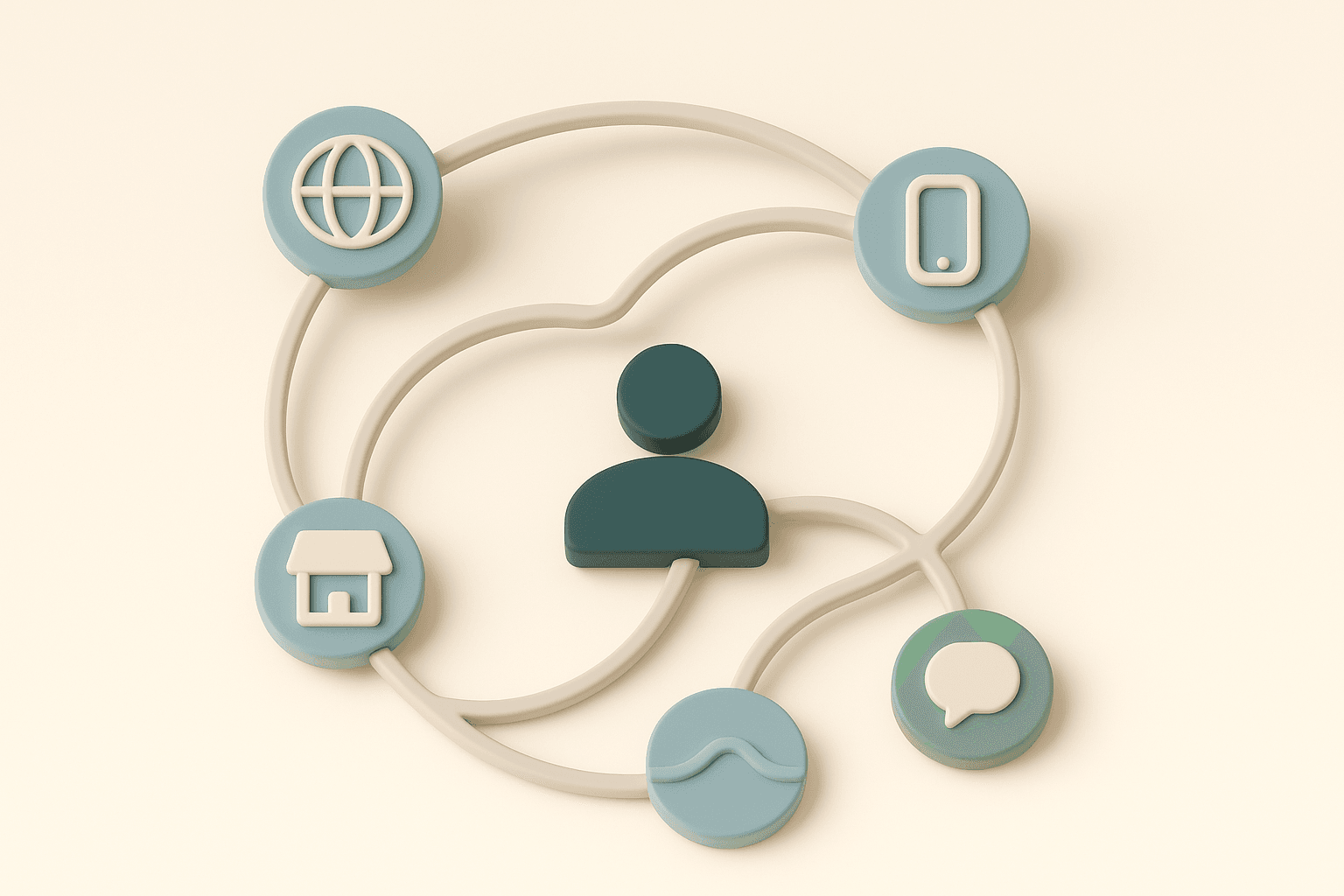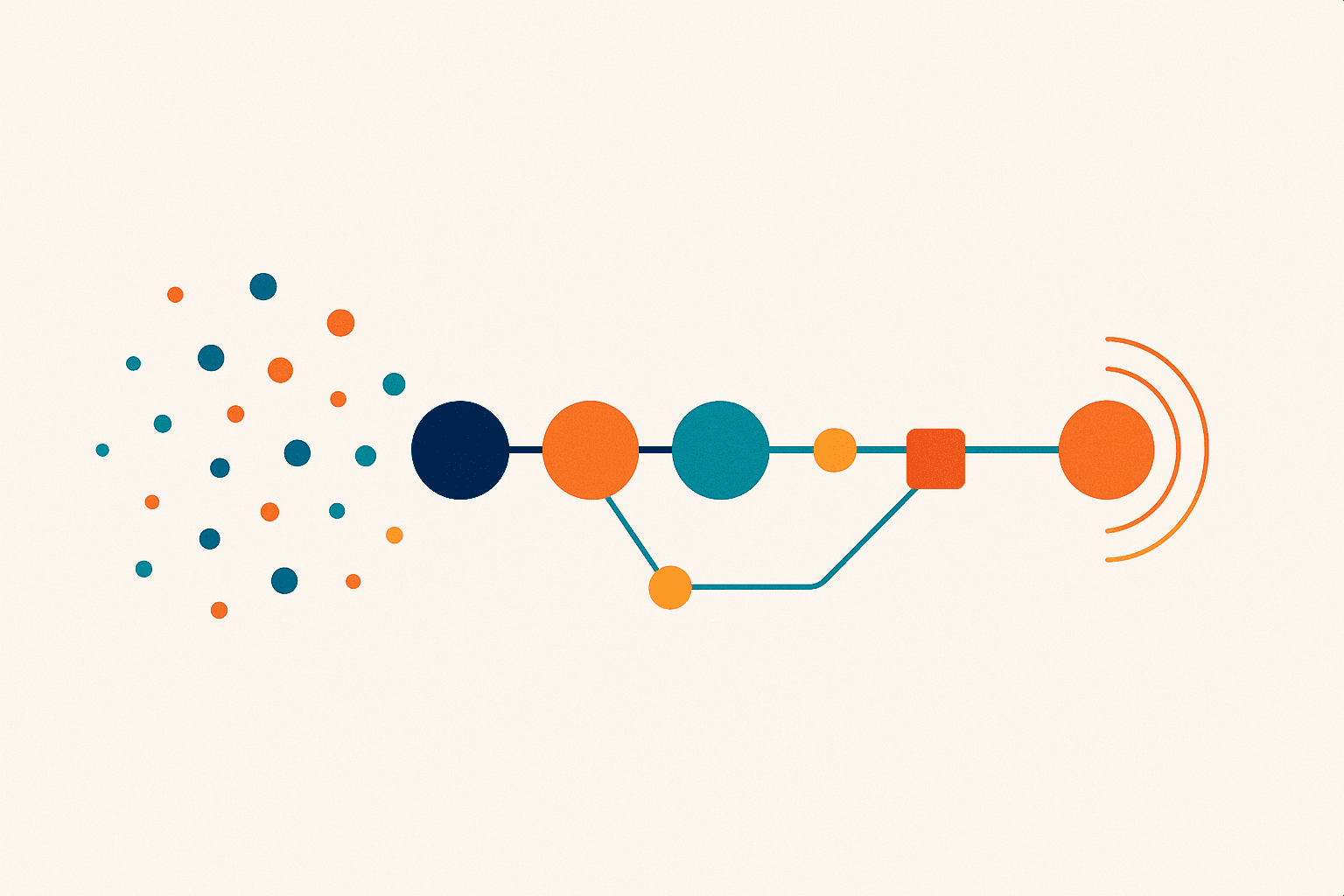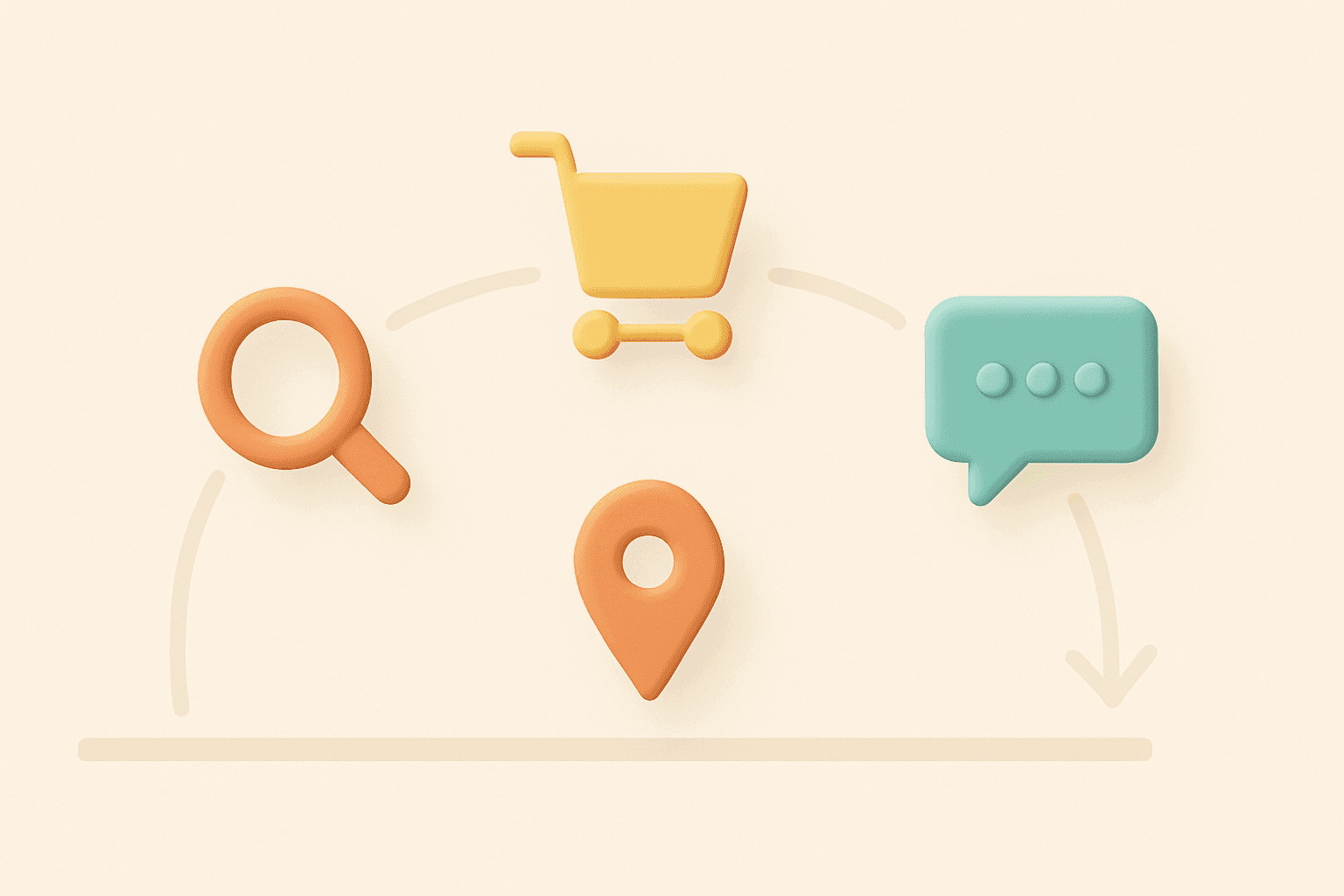What Is Omnichannel Experience? CX Pillars and 2025 Trends for Enterprise Brands
What is an omnichannel experience, and why does it matter now more than ever?
For mid-market and enterprise retailers, omnichannel is the difference between fragmented journeys and seamless, personalized interactions that span every digital and physical touchpoint.
This article unpacks the real meaning of omnichannel experience in 2025, explores the systems behind it, and offers a CX playbook for enterprise teams—from data unification to AI-driven personalization and operational rollout.
Let’s get into the pillars, playbook, and metrics that define modern omnichannel success.
What is an Omnichannel Experience?
An omnichannel experience is a connected customer journey that spans every digital and physical touchpoint—web, app, store, service desk, email, and more—without breaking context. It ensures that each interaction picks up where the last left off, no matter the channel.
Unlike multichannel strategies, which operate in silos, omnichannel systems are designed to unify data, synchronize operations, and deliver consistent experiences across the board. The result is continuity: the customer doesn’t repeat themselves, restart their journey, or experience conflicting messaging between platforms.
Enterprise retailers use omnichannel frameworks to build real-time visibility, enable personalization at scale, and eliminate friction across the buying and post-purchase journey. But the path to omnichannel maturity didn’t emerge overnight—it evolved through distinct phases.
The Evolution from Single-Channel to Omnichannel
Omnichannel didn’t emerge overnight. It evolved through distinct phases—each driven by shifts in customer behavior, technology, and data maturity.
Single-Channel (Pre-2000s): Retailers operated through a single touchpoint—usually in-store or online. No data handoff, no continuity. The experience ended where it started.
Multichannel (2000–2015): Brands expanded into new channels—apps, social, marketplaces—but each one functioned in isolation. Teams, tech stacks, and customer data stayed siloed. The experience was broader, not better.
Omnichannel (2015–Present): The shift came when customers stopped thinking in channels—and expected brands to do the same. Omnichannel integrates systems, touchpoints, and data to create a continuous journey. Whether a customer shops on mobile, picks up in-store, or contacts support, the context travels with them.
This transition—from presence to integration—is what defines omnichannel. Not more channels, but connected ones. Not more data, but usable, shared context.
The 5 CX Pillars of a Modern Omnichannel Experience
Successful omnichannel execution doesn’t just require channel presence—it demands systemic coordination across your tech stack, data infrastructure, and CX delivery. These five pillars form the backbone of modern omnichannel customer experiences built for scale, personalization, and operational continuity.
1. Real-Time Inventory & OMS
The first step toward omnichannel readiness is reliable inventory visibility. When stock data lives in disconnected systems—store POS, warehouse ERP, eCommerce backend—it creates availability mismatches, delays, and missed sales.
Modern brands are adopting unified OMS architectures that centralize inventory data across physical and digital channels in real time. This enables features like "buy online, pick up in store" (BOPIS), accurate back-in-stock notifications, and localized delivery timelines—all critical for enterprise-level CX.
From a systems standpoint, this requires an event-driven OMS with real-time sync capabilities and API-first design. It’s the bridge between fulfillment efficiency and customer trust.
2. Unified Customer Profile (CDP)
Enterprise retailers often suffer from scattered customer data—CRM records in one tool, email engagement in another, support interactions somewhere else. The result? Personalization breaks. Context is lost. Journeys feel fragmented.
A Customer Data Platform (CDP) solves this by stitching together every customer interaction—from browsing and purchase history to service and loyalty data—into a single, queryable profile. This fuels omnichannel personalization, improves segmentation, and gives CX teams real-time context, regardless of the touchpoint.
Architecturally, CDPs sit between front-end experience layers and back-end systems, acting as the intelligence hub of the customer journey. When implemented right, they unlock personalization at scale—without breaking continuity.
3. AI-Driven Personalization Layer
Legacy personalization systems rely on static segments and rule-based logic—limiting their ability to adapt to intent, timing, and context. Today’s omnichannel leaders are moving to AI-powered engines that analyze customer behavior in real time and trigger individualized offers, content, and journeys.
This AI layer sits atop your CDP, leveraging behavioral data, purchase patterns, and predictive models to generate channel-aware recommendations. Whether it’s dynamic homepage content, personalized in-store messaging, or chatbot-assisted discovery, every touchpoint adapts to the individual.
The tech stack here often includes ML models, real-time decisioning engines, and content automation frameworks built on top of API-driven front ends.
4. Frictionless Fulfillment & Returns
If customers can’t get their order how, where, and when they want—it’s not omnichannel. The fulfillment layer is where backend orchestration meets last-mile execution.
Brands are investing in systems that support real-time order tracking, multi-location inventory allocation, and reverse logistics workflows that span both digital and physical touchpoints. Features like BOPIS, ship-from-store, and flexible return hubs are no longer optional—they’re core to maintaining customer confidence and margin control.
From a technical standpoint, this requires tight integration between your OMS, ERP, WMS, and customer communication stack—often through middleware orchestration or API gateways. Fulfillment visibility is not just an operations win—it’s a CX multiplier.
5. Consistent Cross-Channel UX
Omnichannel breaks when the customer experience varies dramatically by channel. Whether it’s inconsistent pricing, brand voice, or interface design—context switching creates friction.
Enterprise brands are solving this with centralized design systems, decoupled CMS setups, and composable front ends that deliver uniform UX across every channel—store, app, kiosk, and web. The goal: maintain one brand narrative, delivered through many modalities.
Operationally, this also means aligning content workflows, product data structures, and promotional logic across teams—so every touchpoint reflects the same intelligence.
Omnichannel vs. Multichannel: Why Integration Wins
While both approaches use multiple channels to reach customers, the key difference lies in how these channels work together. Let's explore why integrated omnichannel strategies are outperforming traditional multichannel approaches in 2025.
| Aspect | Multichannel | Omnichannel |
|---|---|---|
| Integration Level | Separate channels operating independently | Fully integrated, seamless experience |
| Data Management | Siloed data per channel | Unified customer data across all touchpoints |
| Technology Stack | Multiple standalone platforms | Integrated systems with central orchestration |
| Customer Journey | Channel-specific experiences | Consistent cross-channel experience |
| Analytics | Channel-specific metrics | Holistic customer journey analytics |
| Customer Data Flow | Captured per channel, not shared | Centralized and real-time |
| Personalization Capability | Channel-based segments | Cross-channel behavior targeting |
Technical Infrastructure Comparison
The technical foundation of each approach reveals stark differences in capability and complexity. Multichannel setups typically maintain separate systems for each channel, creating operational silos. In many multichannel environments, each channel runs on its own stack—POS for stores, CMS for web, third-party apps for mobile. These operate independently, making cross-channel coordination slow or manual.
In contrast, an omnichannel infrastructure requires a unified platform that orchestrates all channels through centralized data management. Starbucks exemplifies this with their integrated ecosystem, where mobile orders, loyalty points, and in-store experiences are seamlessly connected via shared customer accounts, unified order history, and real-time data sync.
Customer Experience Impact
The impact on customer experience is where integration truly proves its worth. Multichannel strategies may expand reach—but they often disconnect the customer journey. Without system integration, context is lost, and every new interaction feels like starting over.
Omnichannel integration eliminates these friction points. For example, Starbucks customers can check store inventory, order ahead, and manage rewards across any channel—mobile, web, or in-store—with all interactions synchronized in real-time. This level of integration has driven a 4% year-over-year increase in same-store sales and significantly higher customer satisfaction scores.
That’s why omnichannel adoption is now closely tied to increases in customer lifetime value, retention, and loyalty scores across enterprise retail.
Omnichannel requires deeper integration and tighter orchestration—but the return is clear. Brands see measurable gains in conversion rates, average order value, and CX metrics. As customer expectations grow, integration is no longer optional—it’s a business mandate.
Core Business Benefits of Omnichannel (2025 Benchmarks)
Customer Experience Improvements
According to Deloitte's 2025 retail analysis, omnichannel shoppers spend 1.5x more per month than single-channel customers. This lift isn’t just transactional, it stems from the continuity and personalization that omnichannel systems enable. When customers can move across touchpoints without friction, their journeys feel more natural, more trusted, and ultimately more valuable.
Business Performance Impact
The same Deloitte report notes that brands delivering unified experiences see measurable gains in conversion rates and reduced cart abandonment. Customers are more likely to complete purchases when pricing, promotions, and inventory availability remain consistent—regardless of where the interaction begins or ends. This consistency directly impacts revenue and margin.
Operational Efficiency Gains
An omnichannel architecture also unlocks major operational wins:
-
Real-time inventory visibility prevents overstock and stockouts across all sales channels.
-
Automated order routing and fulfillment workflows reduce manual interventions and processing errors.
-
Unified data improves forecasting accuracy and demand planning.
-
Integrated returns and delivery systems enable faster, more cost-efficient logistics.
These gains compound as teams eliminate redundancies, streamline handoffs, and operate from a single source of truth across systems.
Metrics That Matter in 2025
Measuring omnichannel performance requires tracking KPIs that go beyond standard channel metrics. The goal isn’t just to track traffic or sales—but to understand how integrated systems and experiences impact long-term value.
| Metric | Why it Matters |
|---|---|
| Customer Retention Rate | Captures long-term relationship strength and loyalty |
| Average Order Value (AOV) | Tracks transaction size across journeys |
| Inventory Turnover | Gauges how efficiently stock moves across channels |
| Cross-Channel NPS or CSAT | Measures satisfaction consistency across digital + physical UX |
| Channel Integration Rate | Tracks seamless transitions between touchpoints |
| Personalization Engagement Rate | Measures response to dynamic recommendations and AI-driven content |
Technical Requirements for Omnichannel Implementation
Omnichannel success isn’t possible without a composable, scalable architecture underneath. Enterprise teams need more than just integrations—they need a stack built for real-time orchestration, consistent context, and modular growth.
Here’s what that foundation looks like.
Core Technology Stack Components
A modern omnichannel system starts with three foundational elements:
Composable commerce engine Must support cross-channel transactions, flexible promotions, and headless delivery layers—across web, mobile, POS, and marketplace endpoints.
Event-driven architecture Enables real-time customer interaction handling, from cart updates and loyalty triggers to inventory shifts and support events. This ensures context stays live as the journey moves across touchpoints.
API gateway + orchestration layer Facilitates secure, performant communication between platforms—OMS, CDP, CRM, CMS, and fulfillment. Acts as the control plane for routing and transformation logic.
Together, these enable a connected, responsive experience layer that can adapt without downtime or monolith rework.
Data Integration Layer
The biggest friction in omnichannel journeys? Fragmented data.
To maintain continuity across channels, brands must centralize their data layer:
-
Unified customer profiles through a CDP or headless CRM
-
Event stream processors for real-time state changes
-
API-driven bidirectional syncing between legacy and modern systems
-
Caching and edge compute to minimize latency at scale
This layer ensures that context, preferences, and inventory data are always in sync—no matter how fast the customer moves.
Security & Compliance at Scale
Enterprise architectures must meet both operational and regulatory thresholds. Core requirements include:
-
End-to-end encryption (at rest and in transit)
-
Role-based access control (RBAC) for system components
-
Geo-specific data residency management
-
Audit trails for every data exchange
-
Automated testing, monitoring, and anomaly detection
Compliance isn’t a checklist—it’s continuous. Your security architecture must scale with new channel additions, regulatory shifts, and evolving consumer privacy standards.
Enterprise Readiness Principles
Your tech stack must support:
-
Channel modularity — easily plug in or retire customer-facing surfaces
-
Real-time orchestration — from inventory to personalization to fulfillment
-
Resilience — fallback mechanisms for third-party services
-
Performance SLAs — across global regions, edge locations, and device types
This is the backbone of true omnichannel delivery—not just marketing surface alignment, but full-stack, data-aware, interaction-coordinated architecture.
Implementation Roadmap: From Audit to AI Optimization
Building omnichannel maturity is a phased transformation across systems, data, and CX delivery. For enterprise brands, especially those with $200M+ in revenue and legacy dependencies, the roadmap must balance quick wins with long-term scalability.
Here’s a four-phase implementation framework built for that reality.
Phase 0 – Audit: Data, Systems & Gaps
Start with a cross-functional audit of your current architecture. Most enterprises uncover:
-
Disconnected customer data across platforms
-
Redundant workflows between store ops, ecommerce, and service
-
Legacy systems with no real-time sync capabilities
You’ll need to map every touchpoint, identify integration bottlenecks, and assess data quality. This phase often takes 4–6 weeks and lays the groundwork for data consolidation, governance, and orchestration.
Phase 1 – Foundation: Core Integrations & Infrastructure
With your data model defined, connect the core stack—CRM, ERP, PIM, CDP, and OMS. This step is where most enterprise brands feel friction from outdated platforms or point-to-point integrations.
Use middleware or iPaaS tools to reduce manual API stitching. If systems don’t play well together, consider layering in a headless orchestration layer.
Estimated timeline: 2–3 months for baseline integration across top-tier systems.
Phase 2 – CX Layer Rollout
Now activate the omnichannel experience layer. This includes:
-
Enabling single-customer view across web, app, store, and support
-
Rolling out loyalty, personalization, and consistent UX patterns
-
Aligning content, offers, and journey orchestration across teams
Design thinking workshops can align front-end UX with backend data models. This phase shifts omnichannel from a data problem to a customer experience engine.
Phase 3 – AI Optimization & Continuous Feedback Loops
With systems integrated and journeys stabilized, the final phase is performance optimization using AI:
-
Real-time personalization and targeting
-
Predictive analytics for inventory, churn, and promotions
-
Feedback loops from CX metrics into content and product logic
This phase is never “done”—you’ll need to train teams, manage model fairness, and evolve logic over time. For many enterprises, this becomes an embedded part of their digital operations playbook.
Each phase builds resilience into your architecture—and precision into your customer experience. Brands that treat omnichannel implementation as an operational discipline (not just a tech project) unlock measurable gains in LTV, satisfaction, and revenue per journey.
The Future of Omnichannel Experience: 3 CX Shifts to Watch in 2025
The future of omnichannel isn't defined by where people shop, it's defined by how they expect to be served across channels. As customers shift from channel-hopping to context-driven journeys, the experience layer must evolve with them.
Here are three key trends shaping omnichannel CX in 2025:
1. Context Memory Across Channels
Customers now expect brands to “remember” them between sessions—even if they switch devices, pause mid-journey, or return after days. This goes beyond logged-in experiences.
The bar is:
-
Show me the item I viewed on mobile when I return on desktop
-
Let me pick up where I left off, in-store
-
Send support messages that acknowledge my last order or complaint
This requires more than session data—it demands a unified interaction history tied to identity and real-time orchestration.
🧠 Implication for CX teams: Rethink how and where you preserve context, not just customer IDs.
2. Channelless Experience Design
Customers don’t think in “channels.” They start on a reel, jump to the PDP, compare via chat, and finish in-store.
In response, leading brands are shifting from optimizing channels to designing for fluidity—where content, offers, and UX adapt regardless of interface.
-
Touchpoints become interchangeable
-
Interfaces become modular
-
The journey becomes responsive to intent, not entry point
🧠 Implication for design teams: Break down journey stages. Design micro-interactions that travel with the customer—like saved carts, comparison states, and wishlists—across surfaces.
3. Emotionally Intelligent CX
The next frontier in omnichannel isn't speed—it’s emotional continuity.
Customers notice when one channel feels cold while another feels helpful. They value tone consistency, acknowledgement of history, and a sense of being “known” without being tracked.
This is driving growth in:
-
Sentiment-aware support systems
-
Empathetic UI patterns
-
Personalization that feels contextual, not creepy
🧠 Implication for product teams: Your personalization engine needs tone as much as logic. What you say—and how you say it—must align across the brand voice, chatbot, and associate scripts.
Omnichannel experience is about recognition, responsiveness, and emotional continuity. The brands that win in 2025 won’t just show up everywhere. They’ll show up coherently, confidently, and contextually—every time.
FAQ: 2025 Buyer Questions About Omnichannel Experience
What is an omnichannel experience?
An omnichannel experience connects every customer interaction—digital and physical—into a single, continuous journey. Whether a customer browses online, shops in-store, or speaks with support, the context carries through, eliminating repetition and friction. Unlike multichannel setups, omnichannel journeys are coordinated across systems, not just duplicated across channels.
How does omnichannel improve customer satisfaction?
Customers feel valued when they don’t have to start over. Omnichannel systems preserve preferences, interaction history, and order context across touchpoints. This leads to faster resolution times, personalized engagement, and a sense of being “known”—all of which directly improve satisfaction and loyalty.
What are the key components of an omnichannel strategy?
At a minimum, you’ll need:
-
A unified customer data platform (CDP or equivalent)
-
Integrated OMS, CRM, and CMS systems
-
Real-time inventory and fulfillment orchestration
-
Consistent UX across all channels
-
Analytics that track the full customer journey—not just per-channel metrics
How do enterprise brands implement omnichannel effectively?
The most successful brands treat omnichannel as a phased transformation:
-
Start with a data audit to eliminate silos
-
Integrate core systems (ERP, CDP, OMS, CRM)
-
Roll out customer-facing features with personalization and continuity
-
Use AI and analytics to optimize experience based on real behavior
Implementation isn't about launching everything at once—it's about sequencing capabilities for long-term scalability.
Is omnichannel experience only for large enterprises?
No—but the complexity scales with size. Mid-market brands benefit from omnichannel by starting with core touchpoints and gradually integrating systems. For enterprise brands, full-stack coordination becomes essential to maintain consistency, trust, and margin across global operations.




